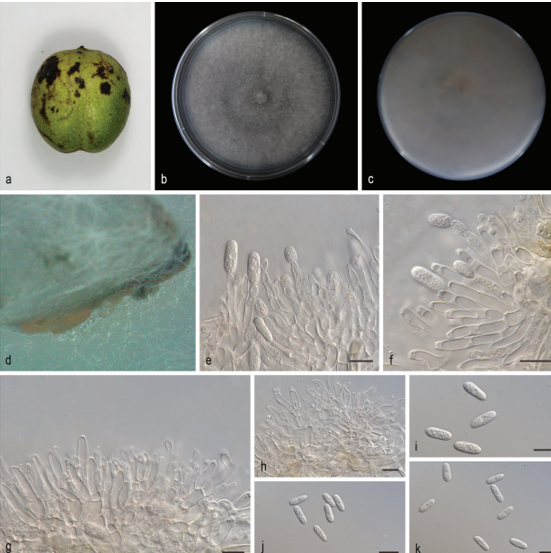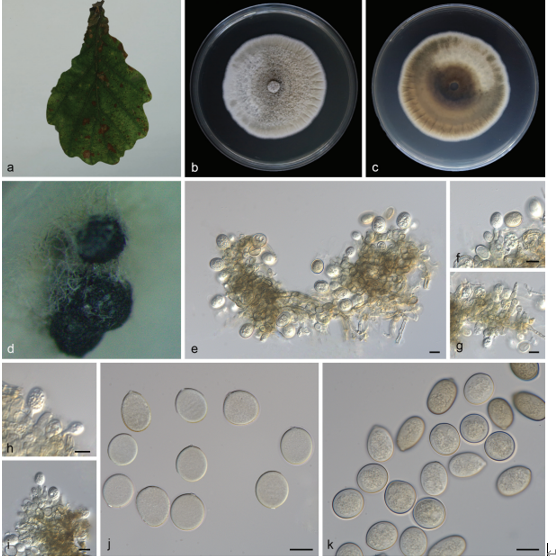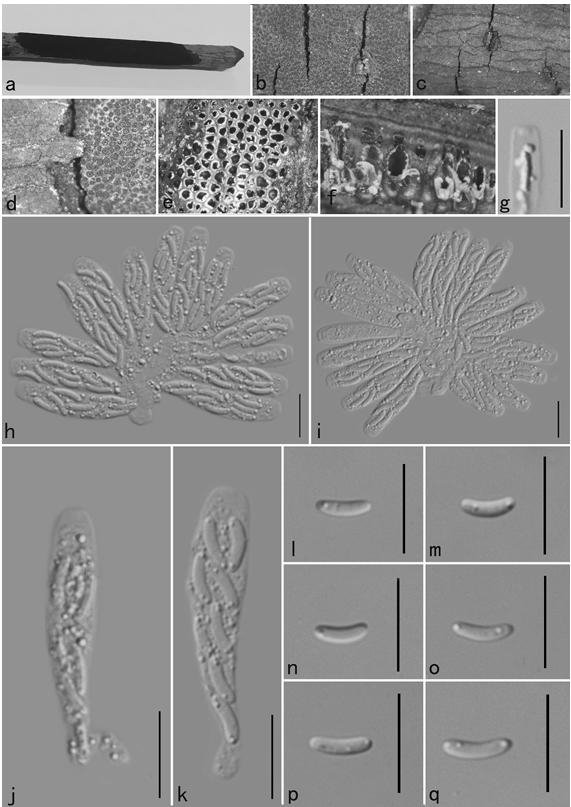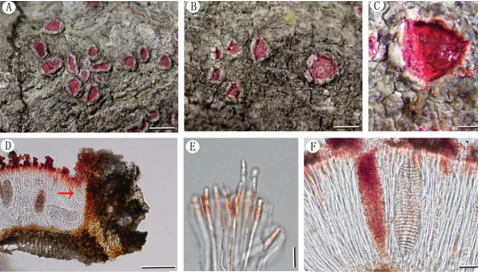Firmiana daweishanensis Gui L.Zhang & J.Y.Xiang, sp. nov. 2020
MycoBank
Holotype: CHINA. Yunnan: Hekou County, Daweishan National Nature Reserve, on limestone hillside, rare, elev. ca. 210 m, in flowers, 1 March 2013, G. L. Zhang 2013001 (holotype SWFC0072399!; isotypes SWFC0072400!, KUN1347143 & KUN1348014!).
Morphological description
Deciduous trees, up to 30 m tall, trunk erect, DBH (Diameter at Breast Height) up to 100 cm. Bark gray to greenish gray, smooth, with longitude fissure. Branchlets green, terete, densely clothed with stellate pilose, similar hairs also on petiole when young and fell off later. Leaf blade ovate to oblong ovate, 16–33 × 11–26 cm, base truncate to shallowly cordate, apex obtuse or acute, abaxial gray-white, densely white stellate-pubescent, adaxial dark green, glabrous, basal veins 5 (–6–7), pink when young, lateral veins 2–4 on each side of the midrib; petiole 11–22 cm long, same color as basal veins when young. Proteranthus (flowering before the leaves). Inflorescence paniculate, terminal, to 50 cm long, densely yellowish white stellately hairy. Calyx purple-red, ca. 12 mm long, hairy, divided nearly to base, densely yellowish stellately tomentose adaxially, abaxially only white villous at base, lobes linear or oblong-linear, ca. 11 × 1.5 mm. Male flowers: androgynophore long, tube-shaped, terete, anthers 30(–35), capitate at apex. Female flowers: ovary ovoid, ca. 2 mm in diameter, longitudinally 5-grooved, densely stellate-pubescent, vestigial anthers ringing the base of the ovary; with gynophore ca. 4 mm long. Follicles membranous, 9–12 cm long, 4–5 cm wide, subglabrous, 1–4-seeded. Seeds yellow-brown, globose, ca. 8 mm in diameter.
Habitat: in valleys or dense forest of limestone mountains
Distribution: southeast Yunnan, southwestern China.
GenBank Accession:
Notes: Among the known 16 species of Firmiana, many are narrow endemics except F. simplex (Linnaeus 1763: 977) W.Wight in Anonymous (1909: 67) (Tang et al. 2007). Morphologically, F. daweishanensis is close to F. hainanensis Kostermans (1957: 308) in its gray to greenish gray bark, ovate leaf blade, and gray-white stellately pubescent on young leaf. But the purple-red flower of F. daweishanensis is different from the yellow-white flower of F. hainanensis. The floral character of F. daweishanensis is also quite similar to that of F. major (W.W.Smith 1916: 130) Handel-Mazzetti (1924: 96) with purple-red calyx, hairy, divided nearly to base, while its bark is quite different from the greenish gray-black bark of F. major, and the ovate leaf of F. daweishanensis is different from the palmately 3-lobed leaf blade of F. major. More obviously, its proteranthus floral character (Fig. 1B) (blossoming in March) makes it distinctive from both F. hainanensis (blossoming in April) and F. major (blossoming in June), which have hysteranthus floral character.
Reference: GUILIANG ZHANG1, 5, LEI CAI2, 6, JIEQIU DUAN3, 7 et al.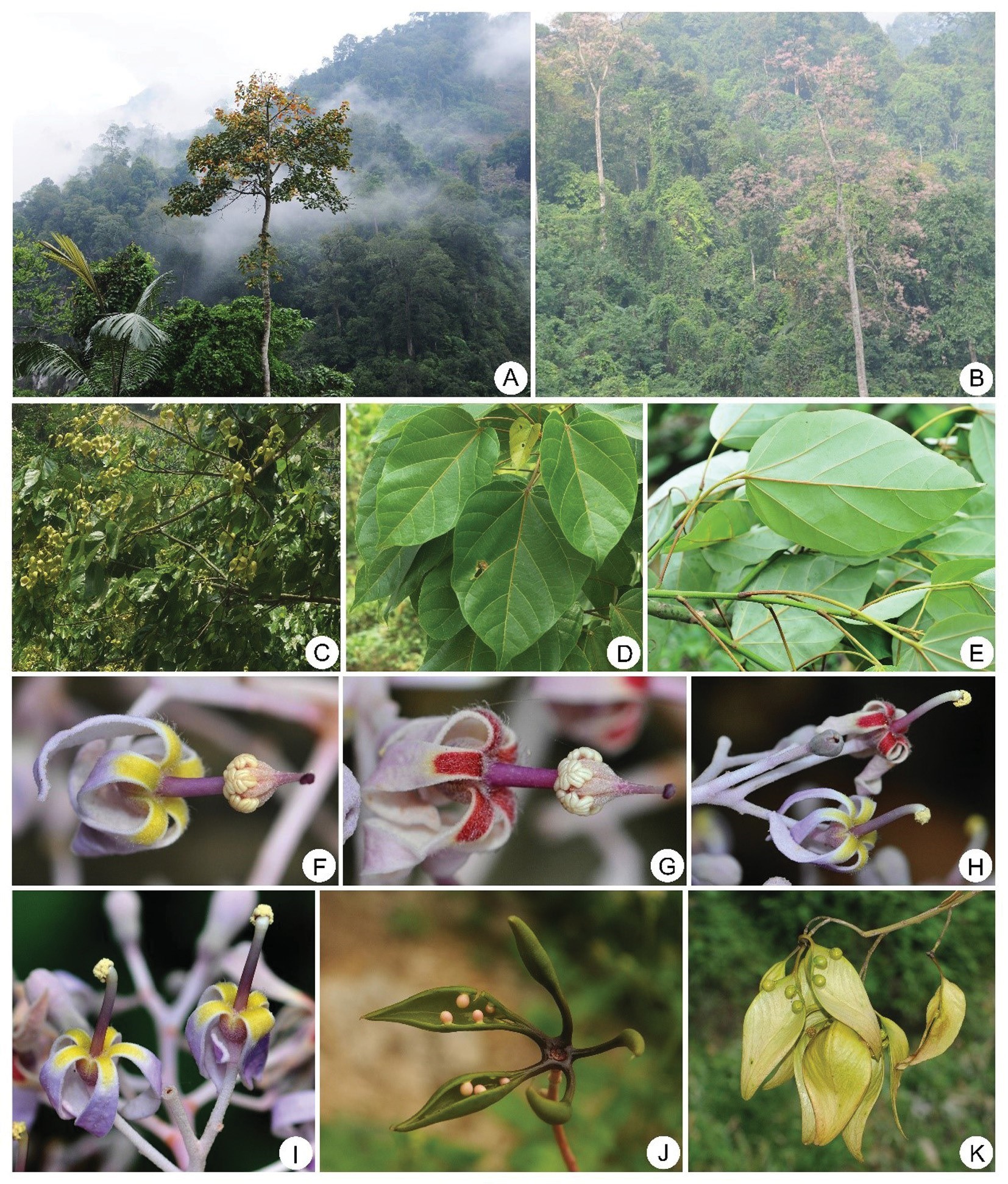
Firmiana daweishanensis Gui L. Zhang & J. Y. Xiang. (A) Habitat, (B) plant in blossom in March, (C) branches in fruit in May, (D) leaf adaxial surface, (E) leaf abaxial surface, (F) female flower just blossom, (G) female flower after pollination, (H) male flower, (I) male flower just blossom, (J) young fruit, and (K) fruit fully opened. (Photo by Gui L. Zhang)


